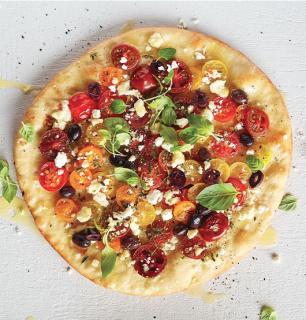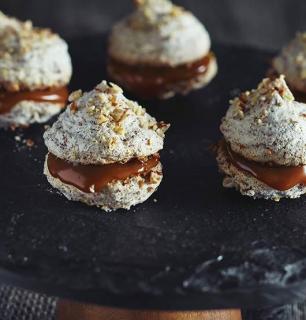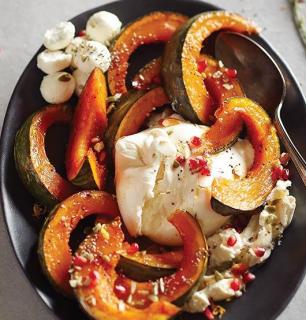The perfect imperfect table, according to Elisheva
“Take your pleasure seriously,” the furniture creator Charles Eames encouraged us. With intricately weaved breadbaskets, fabrics softer than the month of May, a few candles and black bowls dark and dramatic as night, this interior designer/creator of atmosphere, Elisheva San Nicolas, proves to us that dining pleasures are blessings that we create.
In our grandmothers’ kitchens, stoves were cast iron, jars were made from stoneware, tea towels were linen or cotton, sausages were packed in wax paper, and glass bottles made multiple trips, to and from the milkman. At a time when no one could imagine slipping a phone into their pants or bringing their plate of food to eat in front of the TV, the discovery of Fortrel and nylon was perceived as the promise of freedom. We didn’t know yet that these innovations would emerge as trillions of nanoplastic particles discarded in the oceans and that they would return through a salmon’s entrails or even in a tall, clear glass of water. At a time when not one but two telephones hide in the pocket of a blouse, and knowing the condition of our planet, we can no longer claim a lack of information. And now the pendulum swings back: the more virtual our lives become, the more our desire for tangible, plant-based and organic manifests itself. More than ever, coco, jute, clay, wood and wicker reassure, comfort, calm and warm. Elisheva San Nicolas channeled her great love of fabrics in a space named Cœur d’Artichaut. In her Montreal shop flooded with light, the globetrotter with Mexican and Spanish roots exposes and shares her vision of beautiful, useful and unique. The challenge of this woman driven by passions and instinct? Make classic and ethical objects accessible in order to multiply and, at the same time, simplify opportunities for sharing. A constantly changing, growing mission. In 10 “commandments,” she shares with us the keys to a free, simple, generous and welcoming table.
Number 01
You will share your meal
A place primed for comedy and tragedy, delight, unleashing of information, displays of emotion and a platform for confessions, the table is a hub, a place that brings people together, a point where anything is possible. Sacrificing the family meal for individualized technologies is quite simply not an option. Better off dancing on a table than going under it! A tablecloth, a candle, a small vase containing the first peony or the last chrysanthemum of the season… 10 minutes is all it takes to translate this wonderful, sweet intention. And the meal for two, let’s say, on a Wednesday, with the one with whom you have shared the past 13 and a half years of your life, is certainly no exception to the rule.
Number 02
You will foster spontaneity
It’s with a little fanfare that Elisheva San Nicolas campaigns for a certain nonchalance and minimal disorder. She deplores environments that are too orderly and rigid, hinder conversation and impair behaviour. “When everything is too organized,” she says, “it’s intimidating. A certain disorder is indissociable with simplicity. Nothing is more inviting,” says the promoter of a reasonable and conscious abundance, “than a cheese platter on which is placed a hunk of ham to be sliced, a few pieces of juicy stone fruit ready to be bitten into with a few nuts on the side.” At the table, those three wine glasses placed in front of your plate and the 10 utensils formally standing guard around it – save all that pomp for the day you will be eating denti, baby lamb and Scottish grouse (that’s right!) at the table of Pierre Gagnaire on your next stopover in Paris!
Number 03
You will prefer natural
Travolta in Pulp Fiction, Kinski in Fitzcarraldo, Streep and Redford in Out of Africa were all dressed in linen. Their perfect casualness is certainly attributed to the cut of the clothes, but what is essentially at the basis of their iconic charm is the fibre.
Linen has the ability to elegantly melt into its environment without ever disappearing. It’s true in fashion, as much as it’s true in decorating. It doesn’t pill, lose its shape, and it softens and relaxes with wear. Neither its growth nor its processing requires the use of chemical products, its production requires minimal water and it is biodegradable.
Topping the list of table linens that Elisheva adores is the traditional white square linen tablecloth, appropriate for all seasons. Multi-use panels of thinly striped fabric and Lithuanian linens, which are really quite affordable, follow closely behind.
Choosing fabrics like linen, hemp, sisal, jute and coco, which acquire a nice patina with use, is to appreciate the beauty of their imperfections and their evolutionary potential.
This “return” to so-called sustainable, green or ethical practices is not so much a trend, but a form of continuity, a logical next step that leads us to reconnect with forgotten actions and with items made locally and of superior quality. With the prevalence of allergies, distancing ourselves from chemicals is hardly the result of a whim; it is a conscious act motivated by the intention to protect the environment and the welfare of both producers and consumers alike.
Number 04
You will respect colour
According to Goethe, colour is a darkening of light and a lightening of darkness. Yellow is the colour nearest to light while blue approaches darkness. Elisheva fights tooth and nail to give light the place it deserves. “The purity of white is vital! It illuminates, purifies, lightens and frees,” she claims. There is no such thing as too much white at the table. Only once the presence of white is established, light, natural shades of bluish grey, clay and hints of sand are also safe choices. The smallest objects – table napkins, cushions, etc. – will bear the responsibility of bringing accents of stronger colours, that is, very dark, like brown and slate grey. The golden rule: stay close to shades that generate pigments of nature such as red clay, variations of the earth in sienna, ultramarine and anthracite, but also, in smaller doses, rich, vibrant yellows or powerful matte oranges.
Number 05
You will ask questions
Buy little, but better and over time, that is, before pointing your finger and reciting “Eeny, meeny, miny, moe” when choosing your credit card, it’s a good idea to ask yourself a few questions. Here are three that come to mind: a) Will the product that I am buying only last one spring or longer? b) Who is my money going to? We can convince ourselves that our little acts don’t change anything, but everyone knows that if we all stopped encouraging businesses that accept and perpetuate unhealthy practices, things would really change, and quickly. c) What are the effects of my purchases on the environment? The composition of an object, the country that produced it and the advertised price speak volumes about its ethical value. The market proposes interesting “100% carbon-neutral” collections, affecting all stages of the lifecycle of the creations – production, processing, packaging, shipping, retail and final disposal. To be considered.
Number 06
Beware of overload
According to Elisheva San Nicolas, the most common table-planning mistakes are the obsession with perfection and overload.
We’ve said it – excess items create discomfort. An overabundance of flowers creates obstruction between guests and often unwelcome fragrance. Thinking in terms of small and simple is an art that has its charm.
“Do more with less.” This popular minimalist approach poses a challenge: how do we know where to draw the line between not a lot and not at all? “When favourite foods become decorative items, you’ve just found part of the answer,” asserts Elisheva. “And when no one is speaking, if the objects that you have arranged do not distract from the focus, light a candle, choose an appropriate musical backdrop and refrain from adding anything more. Voila!”
Number 07
You will combine styles
A Tunisian bowl, a Portuguese plate, a small goblet reminiscent of Spanish beer glasses, an African breadbasket: placed on a relaxed-weave table runner acquired on the Chemin du Roy en route towards the Grondines, the arrangement is hyper harmonious. It just needed to be tried! Mismatched dinnerware, roughened cutlery, the vintage infuses the contemporary with a soul and the modern cleans up the overload of second-hand elements. The objects have stories to tell and identities to facilitate coexistence. Simply allow them to express themselves.
Number 08
You will honour our artisans
Elisheva believes in the potential of economy of scale and in that of helping each other among smaller players, locally first of all, but also when an ocean separates us. Close to a quarter of the objects that she proposes are produced within a small radius, and the artisans with whom she deals generate the inspirations. Imports are meticulously selected, and only the creators concerned about our planet and about workers’ living conditions will be chosen.
Number 09
You will dim the lighting
The lighting? Make sure it’s soft, soft, soft. Music and lighting are pure generators of atmosphere. Both are closely linked. During the day: natural light. In the evening, and any evening for that matter: candles. There’s nothing like a power failure to remind us of the peace caused by its absence. Directional lighting focuses the light and creates islets of privacy. Too pallid and uniform a light prevents us from lingering; this form of lighting is commonly used by fast food restaurants.
Number 10
You will cherish your achievements
Consuming over time implies taking care of the things you enjoy. Regarding natural textiles like bamboo, linen or hemp, it is essential to use quality cleaning products. In fact, their fibres break down when in contact with excessive chemical solutions, bleach ruins them and they are only suitable for the dryer at a low temperature. However, as the Little Prince said, “It is the time you have wasted for your rose that makes your rose so important.”
by Céline Tremblay
Our recipes
See all recipes




